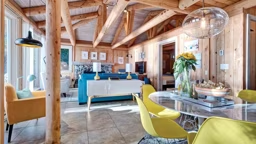
If you’re a nature-lover, few things can rival relaxing at the cabin over a long weekend. Spending your day listening to the dawn chorus, hiking on challenging trails and roasting s’mores under the night sky can help you reconnect with nature’s rhythm and reestablish your love of the great outdoors.
However, have you ever paused to consider the impact that your cabin has on the natural world?
Log cabins may be more eco-friendly than new builds, but appliances like fridges, AC units and lights still use their fair share of energy. Similarly, if you have a clean running water supply, you may accidentally produce more wastewater than you first imagined.
Fortunately, you can make a few tech-based changes to your cabin today to green your getaway location.
Smart Technology
Smart devices and appliances are all the rage in towns and cities. However, the best smart devices are more than a gimmick — they can genuinely reduce your waste and cut down your energy bill. Smart devices can be operated remotely, meaning you can maximize your energy efficiency when you’re away from the cabin.
If you use a sprinkler system to keep your lawn and flowers looking great, consider investing in a smart sprinkler. Smart sprinklers are perfect for when you’re away from the cabin, as they detect weather patterns and only spray your lot when it hasn’t rained for some time.
If you’ve installed Wi-Fi in your cabin, you can use smart thermostats to keep the place cool. This is particularly useful when you’re away, as you’ll want to remotely monitor the temperature to minimize excessive energy use during a cold snap or a heatwave. Just double-check that your HVAC or AC is compatible, as some older systems need to be upgraded.
You can also improve your current appliance’s energy efficiency by installing smart plugs. Instead of replacing old toasters and kettles, use smart plugs to put old appliances on a schedule and lower your electricity bill. This is particularly helpful if you’re attached to old appliances but want to make your time at the cabin more eco-friendly.
Before you leave your cabin, be sure to connect your at-home smart assistant with your appliances at the cabin. Connecting your Alexa or Google Nest with your cabin’s smart devices makes monitoring and adjusting your devices that much easier when you’re away from the cabin.
Electric Vehicle Charging
A weekend away at the cabin is the perfect respite from traffic jams and commutes. However, you may still want to drive to grocery stores and local markets when you’re on-site.
If you have an electric vehicle, minimize your carbon footprint and improve your energy efficiency by installing an EV charger in your cabin. An EV charging station ensures that you’ll never run out of power, no matter how far you decide to explore each day.
It’s important to understand the differences between EV chargers before installing a plug-in point at your home. Level 1, trickle chargers take 40 - 50 hours to fully power a typical EV engine. This is fine if you’re not planning on driving when at the cabin but shouldn’t be your go-to for regular charging.
Instead, consider installing a level 2 EV charger. Level 2 chargers will fill a 60kWh battery in a maximum of 10 hours. This is more than enough time if you’re planning an excursion to a nearby town or area of natural beauty.
Solar Panels
Minimize your CO2 pollution and maximize your energy efficiency by installing solar panels on your cabin. Solar power is perfect for cabins, as you’ll be able to collect and store power while away from your house in the woods. Solar photovoltaic panels (PVs) can be scaled to the size of your cabin and redesigned to look like slate or tiles. This preserves the appearance of your home-away-from-home while powering all your appliances.
Depending on your location, you may be eligible for tax credits when installing solar panels. This will reduce your income tax and help you recoup some of the costs for installation. There is no maximum amount that can be claimed, and the tax credit scheme is currently planned to run until 2035.
You can also consider passive solar design if you’re hesitant about installing large solar panels. Passive solar design heats, lights, or cools your home with tactful use of windows, skylights and natural materials. For example, if you notice that your living room is usually cold, you could consider installing a thermal mass wall on a south-facing side. This will slowly absorb heat and keep you warm throughout the day.
High-tech eco-friendly upgrades, like EV chargers and smart thermostats, can improve your quality of life and reduce your cabin’s carbon footprint. Even small changes, like installing smart adapters on outdated appliances, can significantly reduce your energy use. Consider installing solar panels to make the most of your green tech and redesign some elements of your cabin to minimize your footprint.










